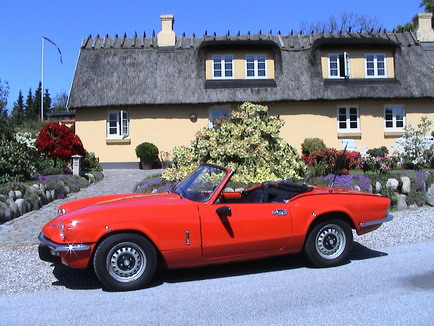
Triumph Spitfire MK IV

 |
        |
| Generel Information / General Information | |
| Mærke / Manufacturer | Triumph |
| Type / Model | Spitfire |
| 1ste Reg. År / First Reg. | 1972 |
| Farve Interior / Colour Interior | Sort / Black |
| Farve Eksterior / Colour Exterior | Rød / Red |
| Motor / Engine | 4 cyl. Række / Row |
| Slaglængde / Stroke | 75.9 mm / 2.99 in |
| Boring / Bore | 73.7 mm / 2.90 in |
| Kubik / Capacity | 1296 cc / 79.1 cu in |
| Kompression / Compression | 9.0:1 |
| Hestekræfter / Max. horsepower | 58 HK / 58 HP |
| Topstykke / Head | Jern / Cast-iron |
| Karburering / Carburettors | 2 x SU |
| Gear / Gearbox | 4 manual |
| Bremser / Brakes | --- |
| Hjul / Wheels | --- |
| Historie / History |
|
I 1962 introducerede Britiske Triumph en 2 sædet sportsbil med navnet Spitfire. Austin Healey Sprite havde bevist, at der var behov for små biler med sporty identitet. Triumph ønskede en del af marked og mente de kunne producere en bedre bil end Sprite.
I September 1960 begyndte konstruktionen af prototypen, hvis kodenavn var ”Bomb”. Triumph benyttede de mekaniske dele fra deres lille saloon med navnet Herald og ”transplanterede” dem til Spitfiren. Basalt set blev en sporty body anbragt på chassis’et af en Herald. Den Italienske designer Giovanni Mechelotti som havde medvirket til designet af Triumph Herald blev taget med på råd i designet af Spitfire. På kort tid var prototypen med en standard Herald 948 cc motor færdig designet. Fronten er designet i et stykke og tiltes forover, for adgang til motor. Spitfiren var klar til serie produktion, men salget for Triumph havde været meget dårligt i 1960 og ved udgangen af året var Triumph i økonomiske vanskeligheder. Heldigvis var Leyland Motors på udkig efter muligheder til ekspansion og fandt Standard-Triumph som en god mulighed. Leyland Motors havde opbygget en succesfuld forretning med produktion af lastvogne og busser. April 1961 var aftalen på plads og Triumph kunne igen producere biler.
Inden produktionen blev der enighed om navnet Spitfire… samme navn som kampflyet der blev benyttet under 2. Verdenskrig. Om der kan drages paralleller til kampen for overlevelse af Triumph melder historien ikke noget om! Over Spitfirens levetid fra 1962 til 1980, var der fem versioner, MK1, MK2, MK3, MKIV og 1500. Da den kom på marked var den ca. 10% dyre end Austin healey Sprite og var det stort set i hele sin produktionstid.
In 1962 Triumph introduced a two seater sportscar by the name Spitfire. A market for this small, not too expensive type of car had been proven by Austin with their introduction of the Healey Sprite. Triumph wanted to have their part of the market and meant that they could produce a far better car than the Sprite.
The construction of the prototype with the codename Bomb started in September 1960. Triumph used mechanical parts from their small saloon Herald and basically just planted a low sporty two seater body on a topless Herald.
The Italian designer Giovanni Mechelotti who had worked with the design of the Herald also helped designing the new Spitfire. In a very short time the prototype with a standard 948cc engine was ready. The front body part was designed as a one piece flip-front for easy access to the engine.
The Spitfire was ready for production, but Triumph had trouble selling their cars in 1960 and at the end of the year they had serious financial trouble.
Luckily for Triumph, Leyland Motors was out looking for the possibility for expansion and found that Standard-Triumph was an opportunity for this. At that time Leyland Motors had a successful business making lorries and busses. In April 1961 the deal was made and Triumph could once again produce cars.
Before the production started, the name Spitfire was decided. The same name as the famous fighter plane from the second world war. Whether they picked the name for the new car because it was to be send out to fight the financially war for the company hasn’t been confirmed, but it has a nice ring to it. During the production period from 1962 to 1980, the Spitfire came in five versions MK1, MK2, MK3, MKIV and 1500. Right from the start it cost about 10% more than the Austin Healey Sprite and it kept that gap during its production period.
|
| Bemærkninger / Notice |
|
|
| Pris / Price | |
| Pris i DKK (Incl. told, moms, reg. afgift og nr.plader)
|
--- |
| Price EUR (Duty & VAT paid inside EEC)
|
--- |
 Gå tilbage til oversigten
Gå tilbage til oversigten